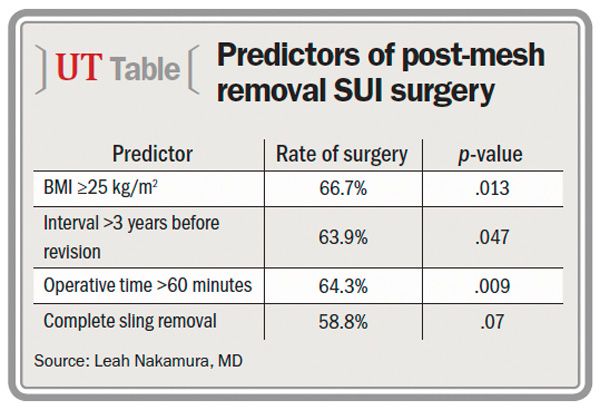Article
Incontinence following mesh sling removal common
Author(s):
Following suburethral mesh sling removal, half of patients had operations to treat incontinence, according to a study reported at the AUA annual meeting in San Diego.
Los Angeles-Following suburethral mesh sling removal, half of patients had operations to treat incontinence, according to a study reported at the AUA annual meeting in San Diego.

Overall, two-thirds of patients had some form of stress urinary incontinence (SUI) after sling removal, including a majority of patients who were continent prior to sling removal. Higher body mass index (BMI) and longer operative time were the only predictors of surgery for incontinence after sling removal.
“This study is one of the few to report reoperation rates for incontinence after suburethral sling removal. Incontinence after mesh removal is a significant adverse effect that patients should be appropriately counseled about preoperatively,” said first author Leah Nakamura, MD, a urology fellow at UCLA, who worked on the study with Shlomo Raz, MD, Larissa V. Rodriguez, MD, and colleagues.
The frequency of mesh-removal procedures has increased in recent years, likely the consequence of several factors: an FDA warning against use of vaginal mesh in 2008; a growing volume of vaginal mesh surgical procedures; a complication rate that probably exceeds those reported in the literature; and perhaps the growing number of lawsuits related to mesh slings.
Few studies in the literature have examined outcomes after mesh removal, said Dr. Nakamura. To address the issue, the authors evaluated the frequency of incontinence after removal of suburethral mesh slings, focusing on the rate of subsequent incontinence surgery after sling removal.
A retrospective review of records from January 2001 to May 2012 was performed to identify patients who had undergone mesh-removal procedures. Continence status before and after mesh removal was documented. The search revealed 110 patients, 14 of whom were lost to follow-up, leaving 96 patients for analysis.
The patients had a mean age of 56.6 years, mean body mass index of 27.6 kg/m2, and mean parity of 2.7. The time from sling placement to removal averaged 2.84 years. Two-thirds of the patients were menopausal, and 72% had a prior hysterectomy.
The sling was retropubic in 46 cases (47.9%), transobturator in 41 (42.7%), single incision in two (2.1%), and multiple types in seven cases (7.3%).
Symptoms that led to mesh removal consisted of mesh exposure in 46 cases (47.9%), urinary retention in two (2.1%), obstructive/irritative symptoms in 77 (80.2%), pain in 41 (42.7%), and recurrent urinary tract infections in 23 (24.5%).
Dr. Nakamura reported that 81% of the patients reported some type of incontinence prior to mesh removal, consisting of SUI in 14 patients (14.7%), urge in 17 (17.9%), mixed in 34 (35.8%), and continuous in 12 (12.6%).
The operative time for mesh-removal procedures averaged 76.5 minutes. The mesh removal was partial in 45 cases (46.9%) and total in 54 cases (53.1%). Additionally, 17 patients (17.7%) had concurrent prolapse repair during mesh removal, and 15 (15.6%) had concurrent surgery for incontinence.
64% of patients have post-op incontinence
After sling removal, 62 (64.6%) of the patients had some form of SUI, including 11 of 18 patients (58.9%) who were continent prior to mesh removal. Overall, half of the patients underwent additional anti-incontinence procedures after mesh removal, including 44.7% of patients who were continent prior to mesh removal. Sixteen patients had more than one operative procedure for incontinence.
An analysis of potential factors associated with surgery for incontinence after sling removal showed that heavier patients (BMI ≥25 kg/m2) were almost twice as likely to have surgery (66.7% vs. 34.5%, p=.013). Other significant predictors were interval >3 years before revision (63.9% vs. 40.7%, p=.047) and operative time >60 minutes (64.3% vs. 37.3%, p=.009). Patients who underwent complete sling removal also were more likely to require additional surgery, but the difference from patients who had partial mesh removal did not reach statistical significance (58.8% vs. 40%, p=.07).
In a multivariate analysis, only operative time and BMI remained significant.UT
Subscribe to Urology Times to get monthly news from the leading news source for urologists.
Newsletter
Stay current with the latest urology news and practice-changing insights — sign up now for the essential updates every urologist needs.














